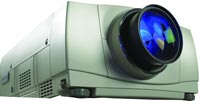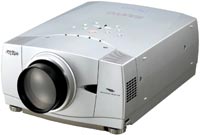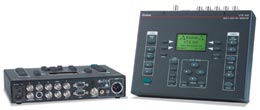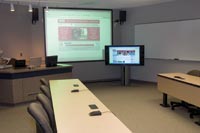Presentation & Display >> The Challenge of Next-Generation
Monitors and projectors are getting slicker and sleeker, but that d'esn’t
mean setting up the smart classroom is without tribulation.

Christie LX50
For her recent presentation at a private liberal arts college, a presenter
confidently pulled out her laptop and set it on the table. Grabbing the handy
VGA cable on the podium, she pulled it across to the table and pushed it against
the back of her computer, but it didn’t feel quite right. Examining the
back of her laptop, she discovered that her new laptop did not have a familiar
VGA output after all; it had a DVI connector. Tech folks and staffers ran here
and there, trying to find an adaptor. In the end, the presentation began 15
minutes late.

Sanyo PLC-XP56
Not too long ago at a city council meeting, a civil engineer plugged his laptop
into the city council chamber’s presentation system. His computer image
appeared on all of the council and audience monitors, but not on the 17-inch
annotation monitor built into the podium. Alas, the monitor could not handle
the wide-aspect image from his laptop.
An architect recently designed a videoconferencing room with the instructor
standing at a podium in the center of the room, directly in front of two rear
projection screens. Now, the instructor is blinded by one or the other of the
projectors, has no nearby whiteboard space on which to work, and the camera
in the back of the room cannot pick up any detail of the instructor’s
face because of the brightly illuminated background. Because all the directional
lights face the audience, there are only about 15 foot-candles of light on the
instructor’s face (when the projectors aren’t blinding him), so
the camera in the back of the room d'es a poor job of resolving facial detail
for the distance education broadcast. How unfortunate.

Extron's VTG-400
These three examples, all true stories, highlight some of the greatest challenges
in working with this latest generation of presentation and display systems.
The same trends that are leading to the next generation of systems are creating
hurdles to be overcome in current product usage. So, let’s look at the
trends and how they will impact (and be affected by) current technologies, then
let’s look ahead to the next generation of presentation and display, and
what you will need to know to get there.
Trend 1: DVI and HDMI
The DVI (Digital Visual Interface) standard was developed by the Digital
Display Working Group to replace the analog VGA standard for computer graphics.
The DVI standard supports bi-directional communication between the source and
display device, to enable them to agree upon an optimized output signal. This
feature, designed for ease of use during setup, makes integration more complex
when dealing with a classroom environment with multiple display devices. The
five-meter maximum range of DVI also poses a challenge: Extenders are available,
but since nearly every installed display device is more than 15 feet from the
source, it’s clearly not integration-friendly.
DVI is seen on two connectors—DVI-I and DVI-D. The DVI-I has pins for
both DVI and analog VGA. With a suitable passive breakout adaptor, you can connect
a VGA display to a DVI-I equipped source. The DVI-D connector is digital-only;
it will only connect to a DVI display, unless you use a DVI-to-VGA converter/scaler.
HDMI (high definition multimedia interface), becoming more important in the
integration world, is essentially DVI in an even more user-friendly format,
with the addition of multi-channel audio. With a form factor similar to but
slightly larger than a USB connector, HDMI is dominating the high-def consumer
market.
Trend 2: Widescreen
Simply put, widescreen is taking over. If you need proof, go down to your local
electronics retailer and compare the number of widescreen laptops for sale versus
conventional 4:3 aspect models. Then compare the number of widescreen projection
televisions versus 4:3 aspect models. The computer formats and resolutions that
have ruled with an iron fist for the past 10-plus years are disappearing rapidly.
Still, not all widescreen is the same. Even within one resolution “standard,”
WXGA, there are multiple native resolutions (1365x768 for large monitors and
projectors, 1280x768 for smaller monitors). Then there’s 1920x1080, 2560x1600,
1280x720, 1440x900, and more. And the aspect ratios of widescreen displays aren’t
consistently 16:9; 15:9 is common, and you’ll find 16:10 out there, too.
Practical considerations for widescreen begin with the layout of the room.
Wide aspect projection screens mean less room in the front for whiteboards,
and more encroachment on where the instructor would stand. The projector typically
needs to be positioned much farther back than a conventional 4:3 projector,
since the image is significantly wider, and a longer throw distance is generally
required. Where projector location is dictated by ceiling soffits or rear projection
room dimensions, this can be troublesome.
Using wide aspect monitors means that the images are less tall than a comparably
sized 4:3 display, so the diagonal monitor size must be larger in order to provide
an equivalent-sized image. For example, a 50-inch 4:3 projection monitor has
an image height of 30 inches. A 50-inch diagonal 16:9 projection monitor has
an image height of only 24.5 inches. You would have to upgrade to the 60-inch
16:9 monitor in order to get back to a 29.4-inch image height. Larger monitor
sizes for equivalent viewing considerations mean a larger footprint (new widescreen
monitors may not fit on old stands or carts) and higher costs (60-inch 16:9
models cost $500 to $1,000 more than 50-inch models).
Finally, widescreen resolutions are not compatible with some legacy equipment—perhaps
those 17- and 19-inch SXGA monitors you just bought with year-end money. When
considering any display purchase, the question “How d'es it handle widescreen?”
must become your mantra. If you want to verify that your sales rep is telling
the truth, the Extron VTG-300
and VTG-400 test signal generators make product testing (and lie detecting)
easy, and even fun.
Trend 3: Projectors Everywhere
A projector in every classroom is a condition no longer exclusively found in
higher education; K-12 districts across the country are installing thousands
of projectors at every level. And, colleges and universities are now relying
on projection, front and rear, to enhance instruction in all fields of study.

NEC's new WT600-DS84
Unfortunately, room designers have often failed to solve the problems that
must be addressed when using projection technology in an instructional space:
- Too much (any) ambient light on the projection screen
- Inadequate lighting of instructor and whiteboards
- Imbalance of whiteboard space/access and the projection screen
- Inadequate sizing of screen and sightlines from audience
- Instructor “wander zone” interfering with projector light field
- Distance education/IP cameras pointed toward screens
- Projector fan noise
When these problems are not solved, a projector can actually detract from the
learning experience. Rear projection, when properly implemented, can solve many
of these problems, but the cost in equipment and square footage is often prohibitive.
Yet, if implementing front projection has so many potential (and sometimes
unavoidable) pitfalls, why do smart people keep doing it? The reason is that
the image is so big. Trying to show an extremely detailed computer image to
people sitting 25 feet away using a 42-inch plasma screen (or even a 60-inch
model) is insufficient. People need to see an image that is of sufficient size
to resolve the detail that is presented, over the distance across which it is
viewed. It’s essentially a three-variable equation, with distance, size,
and detail affecting each other to produce the optimal viewing solution.
Until rear projection monitors (or direct-view flat panels) are large enough to provide equivalent-sized images to projectors, there will still be projectors hanging in classrooms—faults and all.
Until rear projection monitors (or direct-view flat panels) are large enough
to provide equivalent-sized images to projectors, there will still be projectors
hanging in classrooms—faults and all.
Seeking Perfection
Industry marketers are always pitching the Next Best Thing. But how do we know
whether a new product is next generation or simply next-incremental-improvement?
Incremental steps are necessary and beneficial, but the term “next generation”
should be something that moves us toward something. What is the ultimate classroom
display system? Here are four criteria that would need to be met:
- Large enough for everyone to see comfortably
- High-enough contrast for images to look natural in all lighting conditions
- Flexible in accommodating various resolutions and aspect ratios
- Form factor that d'es not interfere with classroom activities

GOOD USE of 50-INCH DLP rear projection monitors at the University of Wisconsin-La
Crosse.
Current Technologies
Love them or hate them, there is little available right now in the area of projectors
to suggest “next generation.” In terms of meeting the criteria of
the ultimate classroom display system, front projectors do well in terms of
image size. The main area of weakness for projectors is in image contrast (front
projection), where the lighting in the front of the room needs to be carefully
controlled to avoid the image being washed out. Projectors vary by manufacturer
and model in terms of how they handle various resolutions and aspect ratios.
As of press time, very few 3000-plus ANSI lumen brightness, affordable (sub-$20,000),
and native 16:9 projectors are available. And projectors dictate to a large
extent the layout and design of a classroom: Once in place, the projector(s)
and screen(s) aren’t likely to be moved, making reconfiguration of the
classroom difficult to achieve.
Small (sub-20 lb.) projectors are continuing to get brighter: The
Christie LX50 and Sanyo
PLC-XP56 are prime examples. Ultimately, it’s not the brightness of
the projector that matters to the end user, but rather the amount of light per
square inch of screen. To get an image on a 150-inch diagonal screen that compares
in perceived brightness to a 2500-ANSI lumen projector shining on a 100-inch
diagonal screen, the projector would need to be more than twice as bright. So
while a 5000-ANSI lumen projector might be uncomfortably bright on a 70-inch
screen, it will work fine with bigger screens in larger rooms.
Monitors are seeing changes and growth, both as flat panels are released in
larger sizes and lower price points, and as HDTV continues to drive development
of large-screen projection monitors. While monitors do well as compared with
front projection in terms of image contrast, they continue to fall short in
terms of image size. And, monitors currently are moving faster than projectors
toward HDMI as the sole input, making integration with existing analog systems
more complex.
The Next Generation
What are the products we will be putting into classrooms in the next three to
five years? Some of them may look like…
1—Really Big Monitors. For a time, NEC
offered the WT600-DS84 with an 84-inch diagonal image in a 16:9 aspect ratio.
While the specifications stated that it would handle “up to 1920x1080
(1080i),” this single-chip DMD device had a native resolution of 1024x576.
Oh, and the list price was $19,995. As a first-generation/next-generation product,
though, it met the four criteria, at least for small-to-midsize classrooms:
It was large, not greatly affected by ambient lighting, and it handled a wide
variety of input signals and resolutions (VGA and DVI input connectors, and
handled HDTV), and the form factor was reasonably compact—only 22.5 inches
deep. Hopefully, more manufacturers will look at the potential for this type
of product, both in classrooms as well as in the home. Watch for prices to drop
as second- and third-generation products emerge.
2—Pretty Big Monitors. Terry Wirkus, Distance
Education manager at the University of Wisconsin-La Crosse, reports that he
is very satisfied with several Samsung
50-inch DLP rear projection monitors that have been used in his classrooms for
a variety of applications, including computer presentations. With 60-inch monitors
currently selling for $2,500 to $3,500, they represent an affordable and viable
solution for smaller rooms, or where there are opportunities for placement of
additional monitors toward the rear of larger/longer rooms.
Monitors in this size and price category come in at least three varieties appropriate
for classroom use: LCD, DLP, and D-ILA. Many video purists insist that CRT and/or
DLP are superior for video due to higher black levels and greater color contrast.
However, it’s important to know that a small percentage of DLP viewers
can be bothered by a phenomenon known as “rainbow artifacts,” wherein
the viewer sees a blur of color around the monitor (this is especially noticeable
via peripheral vision). Newer, higher-speed DLP devices have reduced this problem,
but some people remain sensitive to it. One should also keep in mind that computer-centric
users may prefer LCD, pointing out the sharper pixel lines. If you want to compare
the technologies side by side, I recommend that you take a field trip to your
local big-box electronics retailer. Keep in mind that the settings made to each
display in the store (by the salespeople or by inquisitive customers) can make
any display look better or worse than another. The truth of the matter is, with
a little adjusting, they all can look pretty good.
3—Next-Generation Projectors. While not really
new, I contend that the NEC
WT-610 is a second-generation/next-generation product. The projector’s
ability to throw a large image from a short distance allows a user to build
(or commission) his own inexpensive rear-projection kiosks. Front projection
works as well, solving most of the light path problems of a typical front-projection
installation: The projector can be mounted just off the front wall of the room,
above the screen, if necessary. While the brightness rating has increased from
1500 ANSI (WT-600) to 2000 ANSI lumens (WT-610), potential buyers should know
that it’s still not really bright enough for larger screens (100-inches-plus),
depending on the ambient room lighting. For rear projection applications, though,
this should do fine.
Another first-generation/next-generation projector is the Sanyo PLV-WF10. It
offers WXGA (1365x768) native resolution with 4000 ANSI lumens of brightness,
at a list price of $12,995. A few cautions, however, when considering purchase
of this product: The noise rating is 46dB, the PLV-WF10 weighs over 46 lbs,
it uses two projection lamps (doubling lamp replacement cost), and the list
price d'es not include a lens. What makes the PLV-WF10 exceptional is that it
offers true WXGA resolution at high brightness something that the many 1280x720
home theater projectors out there fail to do.
About the Author
Will Craig is a Multimedia Systems Design Consultant for Elert & Associates, a nation-wide multi-disciplinary technology consulting firm based in Stillwater, MN.